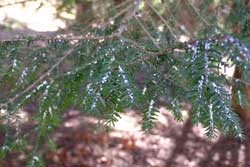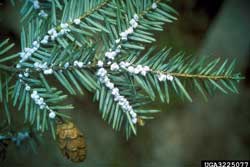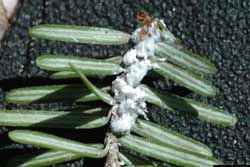Hemlock Woolly Adelgid—Adelges tsugae
Hemlock woolly adelgid (HWA) is a serious pest of eastern hemlock. Damage from HWA feeding causes needles to discolor and drop prematurely. This leads to crown decline, reduced growth and, in some cases, tree death. HWA is spread by wind, birds and mammals, and can be moved on live hemlock plants.
The most obvious sign of HWA is the covering of wool-like wax filaments produced as the insect matures. The woolly masses generally range from 1/16 inch to 1/8 inch across. They are found on the most recent hemlock growth, generally on the outermost branch tips.
Many coastal and southern towns in Maine are known to harbor infestations of this pest. A Hemlock Woolly Adelgid Quarantine is in place to reduce artificial spread of this insect to other parts of the state.
In Maine, please report sightings of this pest to the Maine Forest Service.
The most obvious sign of HWA infestation are the white cottony masses, resembling cotton balls, found at the base of the hemlock needles.
Click on images to view full-size
Identification and Control Information
- From the Maine Forest Service
- Fact Sheet: Hemlock Woolly Adelgid (PDF)—Cornell University Insect Diagnostic Laboratory
- Entomological Notes: Hemlock Woolly Adelgid (PDF)—Penn State College of Agricultural Sciences Cooperative Extension
More Information
- Importing Hemlocks to Maine, Shipping Requirements—Maine Department of Agriculture, Conservation and Forestry
- Maine Forest Service: Conditions Reports (updated regularly) including annual summary reports
[Photos, left to right: James Johnson, Georgia Forestry Commission, Bugwood.org; Connecticut Agricultural Experiment Station Archive, Connecticut Agricultural Experiment Station, Bugwood.org; Chris Evans, River to River CWMA, Bugwood.org]


